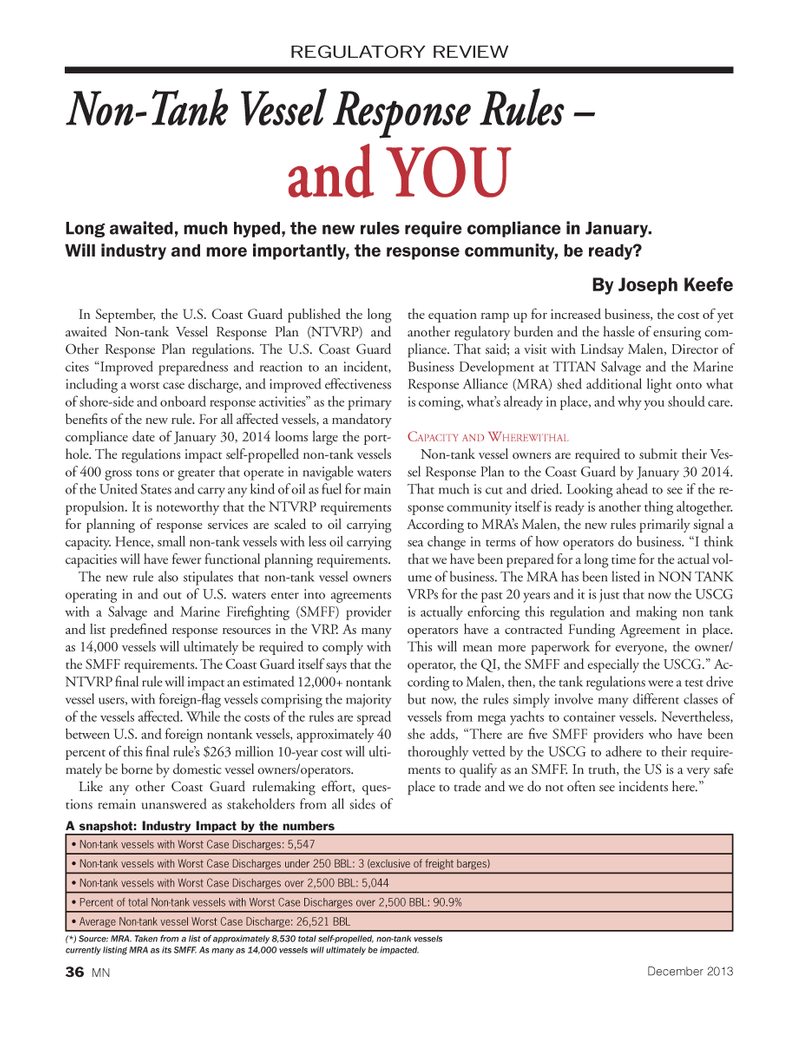
Page 36: of Marine News Magazine (December 2013)
Innovative Products & Boats of 2012
Read this page in Pdf, Flash or Html5 edition of December 2013 Marine News Magazine
In September, the U.S. Coast Guard published the long awaited Non-tank Vessel Response Plan (NTVRP) and Other Response Plan regulations. The U.S. Coast Guard cites ?Improved preparedness and reaction to an incident, including a worst case discharge, and improved effectiveness of shore-side and onboard response activities? as the primary bene ts of the new rule. For all affected vessels, a mandatory compliance date of January 30, 2014 looms large the port- hole. The regulations impact self-propelled non-tank vessels of 400 gross tons or greater that operate in navigable waters of the United States and carry any kind of oil as fuel for main propulsion. It is noteworthy that the NTVRP requirements for planning of response services are scaled to oil carrying capacity. Hence, small non-tank vessels with less oil carrying capacities will have fewer functional planning requirements. The new rule also stipulates that non-tank vessel owners operating in and out of U.S. waters enter into agreements with a Salvage and Marine Fire ghting (SMFF) provider and list prede ned response resources in the VRP. As many as 14,000 vessels will ultimately be required to comply with the SMFF requirements. The Coast Guard itself says that the NTVRP nal rule will impact an estimated 12,000+ nontank vessel users, with foreign- ag vessels comprising the majority of the vessels affected. While the costs of the rules are spread between U.S. and foreign nontank vessels, approximately 40 percent of this nal rule?s $263 million 10-year cost will ulti- mately be borne by domestic vessel owners/operators. Like any other Coast Guard rulemaking effort, ques- tions remain unanswered as stakeholders from all sides of the equation ramp up for increased business, the cost of yet another regulatory burden and the hassle of ensuring com- pliance. That said; a visit with Lindsay Malen, Director of Business Development at TITAN Salvage and the Marine Response Alliance (MRA) shed additional light onto what is coming, what?s already in place, and why you should care. CAPACITY AND WHEREWITHAL Non-tank vessel owners are required to submit their Ves- sel Response Plan to the Coast Guard by January 30 2014. That much is cut and dried. Looking ahead to see if the re- sponse community itself is ready is another thing altogether. According to MRA?s Malen, the new rules primarily signal a sea change in terms of how operators do business. ?I think that we have been prepared for a long time for the actual vol- ume of business. The MRA has been listed in NON TANK VRPs for the past 20 years and it is just that now the USCG is actually enforcing this regulation and making non tank operators have a contracted Funding Agreement in place. This will mean more paperwork for everyone, the owner/ operator, the QI, the SMFF and especially the USCG.? Ac- cording to Malen, then, the tank regulations were a test drive but now, the rules simply involve many different classes of vessels from mega yachts to container vessels. Nevertheless, she adds, ?There are ve SMFF providers who have been thoroughly vetted by the USCG to adhere to their require- ments to qualify as an SMFF. In truth, the US is a very safe place to trade and we do not often see incidents here.? Non-Tank Vessel Response Rules ? Non-Tank Vessel Response Rules ? and YOU and YOU Long awaited, much hyped, the new rules require compliance in January. Will industry and more importantly, the response community, be ready? By Joseph Keefe REGULATORY REVIEW Non-tank vessels with Worst Case Discharges: 5,547 Non-tank vessels with Worst Case Discharges under 250 BBL: 3 (exclusive of freight barges) Non-tank vessels with Worst Case Discharges over 2,500 BBL: 5,044 Percent of total Non-tank vessels with Worst Case Discharges over 2,500 BBL: 90.9% Average Non-tank vessel Worst Case Discharge: 26,521 BBL A snapshot: Industry Impact by the numbers(*) Source: MRA. Taken from a list of approximately 8,530 total self-propelled, non-tank vessels currently listing MRA as its SMFF. As many as 14,000 vessels will ultimately be impacted. December 201336 MNMN Dec2013 Layout 32-49.indd 36MN Dec2013 Layout 32-49.indd 3611/25/2013 12:49:49 PM11/25/2013 12:49:49 PM

 35
35

 37
37
